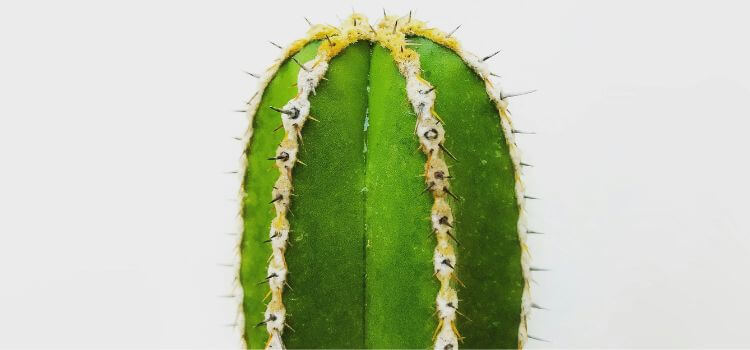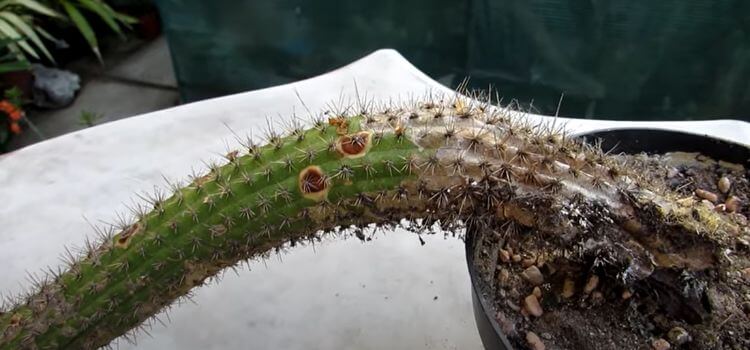As an Amazon Associate, I earn from qualifying purchases.
To tell if a cactus is dead, check for discoloration and softness. Dead cacti often appear brown and mushy.
Cacti are resilient plants, often thriving in harsh conditions where other plants would perish. Despite their hardiness, they can fall victim to overwatering, underwatering, or fungal infections, leading to their demise. A healthy cactus should exhibit a green, firm surface free of dark spots or a cotton-like substance – signs of potential problems.
Cactus enthusiasts must recognize the symptoms of a dying plant early. Timely intervention can save a struggling cactus, but revival chances diminish once it crosses a certain threshold. The turgid flesh and brilliant colours of healthy desert dwellers help identify life.
How To Tell If A Cactus Is Dead?
Do you have a cactus that looks unhealthy? Are you wondering if it’s dead? Cacti are tough, but they can die. Here are some signs to help you know if your cactus is dead.
Mushy Texture
A cactus in prime condition should feel sturdy. If the texture turns soft, your cactus might be in trouble. When a cactus appears faded, it’s often a sign of dehydration. Overwatering, however, could lead to a mushy texture.
- Shrivelled: Lack of water can cause a cactus to shrink and wrinkle.
- Mushy: Too much water can lead to root rot, making the cactus soft and squishy.
Discoloration And Brown Spots
Vigorous cacti boast vibrant colours. Yellow or white areas suggest a lack of nutrients or water. Brown spots can indicate rot or fungal infections.
| Colour Issue | Possible Cause |
|---|---|
| Yellow/White Areas | Underwatering, nutrient deficiency |
| Brown Spots | Overwatering, fungal disease |

Disease And Pest Infestation
Cacti are resilient plants known for their ability to thrive in harsh conditions. But even these hardy beauties can fall prey to diseases and pests, which can be fatal if unnoticed. You must recognize these symptoms to determine if a cactus is dying or needs TLC.
Common Cactus Pests
Pests can wreak havoc on cacti, leading to severe stress or even death. Look out for these common offenders:
- Mealybugs: Tiny, cotton-like pests clumping in nooks.
- Spider mites: Microscopic bugs creating delicate webs.
- Scale insects: Hard or soft shell bugs, sucking plant sap.
Symptoms Of Fungal Diseases
Fungal diseases can be silent killers in cacti. Stay alert for these symptoms:
| Symptom | What It Means |
|---|---|
| Black Spots | Fungal growth on tissue. |
| Rotted Base | Stem softening from the bottom. |
| Yellowing | Plant losing its vibrant colour. |
Damage from pests or diseases often leaves a cactus vulnerable to further issues. Early identification and action can save the plant. A cactus that has ultimately succumbed generally cannot be revived. Assess your cactus regularly for these signs.

Reviving A Dying Cactus
Spotting a dying cactus can be heartbreaking. Cacti are usually tough plants, but they can suffer too. Reviving a dying cactus is possible with some care. The steps below will guide you on how to bring your cactus back to life.
Adjusting Watering Schedule
Too much or too little water spells trouble for cacti. Start by letting the soil dry out completely between waterings. Only water your cactus when the top inch of soil feels dry.
- Check the drainage of your pot.
- Use a pot with holes in the bottom.
- Water less in winter, when cacti enter dormancy.
Creating Optimal Light Conditions
Cacti crave plenty of light, but not all like direct sunlight. Move your cactus to a spot where it gets indirect, bright light for most of the day. This can prevent sunburn and revive its vigour.
| Location | Hours of Light | Direct/Indirect |
|---|---|---|
| East-facing window | 4-6 | Indirect |
| South-facing window | 6+ | Mixed |
When And How To Report
Repotting can kickstart growth in a thick cactus. Choose a pot just one size larger than the current one. Ensure it has good drainage and use fresh cactus soil mix. Repot during active growth seasons, such as spring or early summer, is best.
- Remove the cactus carefully to avoid spines.
- Shake off old soil and inspect the roots.
- Trim any rotted or dead roots.
- Place in new pot and backfill with soil, pressing lightly.
Remember, patience is vital. Resuscitating a cactus happens after some time. Monitor shifts and adjust care as your cactus shows signs of revival. Consistency will bring your desert buddy back to its robust self!
Preventive Measures
Taking care of cacti means giving them attention before trouble starts. Preventive measures help your spiky friends stay healthy. With the right routine and seasonal tweaks, you can spot early signs of distress and act quickly. The goal is to never have to ask, “Is my cactus dead?”
Routine Monitoring
Regular check-ups keep your cactus happy. Look for changes in colour, texture, and growth. Spots or wrinkles mean, “Help me!”
- Colour Shifts: A healthy cactus has vibrant colour. Dullness can signal a problem.
- Squishy Base: This could mean root rot. Act fast if you feel it!
- Spine Health: Spines should be firm and intact. Droopy or missing spines are red flags.
Seasonal Care Adjustments
Cacti needs change with the seasons. Adjust water and sun exposure as the weather shifts.
| Season | Watering Needs | Sun Exposure |
|---|---|---|
| Spring | Increase moderately | Full sun |
| Summer | Keep soil slightly moist | Partial shade |
| Fall | Reduce gradually | Reduced sun |
| Winter | Water sparingly | Indirect light |
Proper Soil Selection
Choosing the suitable soil is crucial. Your cactus wants well-draining soil to avoid wet feet.
- Well-Draining Mix: Gravel or sand in the mix allows water to flow.
- pH Levels: Cacti prefer slightly acidic to neutral soil. Test regularly!
Frequently Asked Questions Of How To Tell If A Cactus Is Dead
Fading, discolouring, or mushy cactus pieces indicate death. A hollow, rotten base and falling leaves or spines imply death. Firmness and healthy tissue indicate vitality.
Check your cactus for firm, green flesh, minimal discoloration, and steady growth. Healthy spines, rot-free roots, and no bugs indicate health. Wilted, yellowed, or mushy sections need fixing.
A dehydrated cactus appears shriveled, with wrinkled skin and a dull, often pale colour. It may lean or show signs of puckering.
Carefully removing damaged sections and reinstalling healthy ones in fresh soil can save a rotting cactus.
Conclusion
Caring for cacti can be simple. Recognizing the signs of life—or its absence—is vital. Ensure regular checks for firmness, colour, and root integrity. Prompt action can revive a struggling cactus. Embrace these tips to keep your spiky friends thriving.

